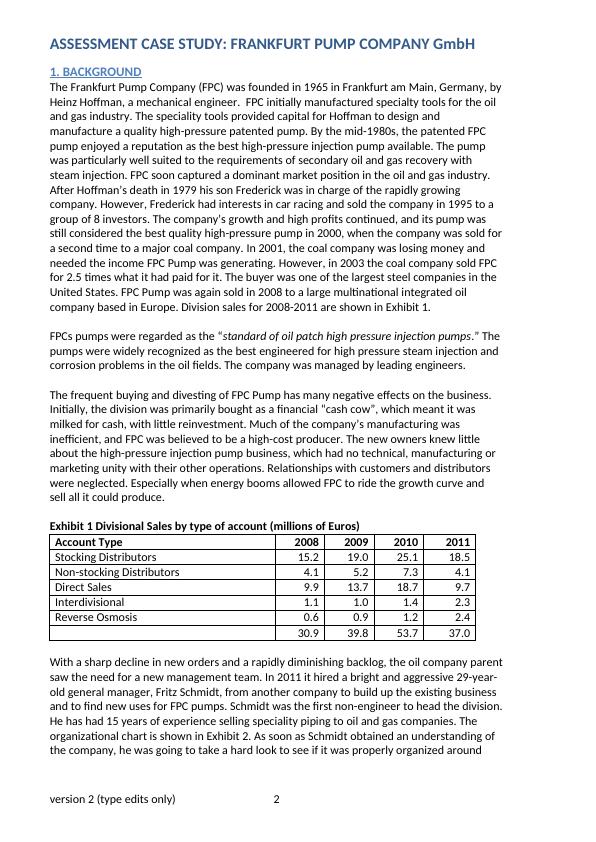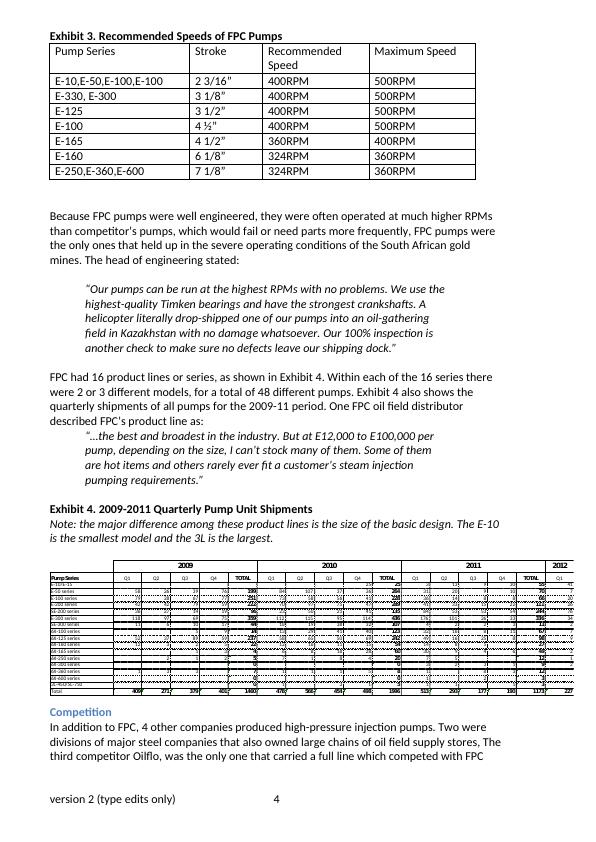Ask a question from expert
Business to Business Marketing Management
18 Pages7380 Words919 Views
Added on 2019-09-20
About This Document
Comprehensive Case: The Frankfurt Pump Company GmbH (FPC) where we will discuss product lines, end-users, the aftermarket, distribution, pricing, and profit mix. FPC soon captured a dominant market position in the oil and gas industry. FPC comes around and makes promises, but nothing happens. They have no set policies for distributors. Our pump distributors have engineers who go in and evaluate an end user’s requirements and specifications before submitting a price quotation.
Business to Business Marketing Management
Added on 2019-09-20
BookmarkShareRelated Documents
CONTENTSASSESSMENT CASE STUDY: FRANKFURT PUMP COMPANY GmbH...................................31. BACKGROUND...........................................................................................................32. PRODUCT LINES.........................................................................................................43. END USERS.................................................................................................................74. THE AFTERMARKET....................................................................................................95. DISTRIBUTION..........................................................................................................126. PRICING AND PROFIT MIX.......................................................................................17ReferenceZimmerman, A. & Blythe, J. (2013) Comprehensive Case: The Frankfurt Pump Company GmbH (FPC) pp474-492 in Zimmerman & Blythe, Business to Business Marketing Management A Global Perspective, Second Edition. Abingdon: Routledge.version 2 (type edits only)1

ASSESSMENT CASE STUDY: FRANKFURT PUMP COMPANY GmbH 1. BACKGROUNDThe Frankfurt Pump Company (FPC) was founded in 1965 in Frankfurt am Main, Germany, byHeinz Hoffman, a mechanical engineer. FPC initially manufactured specialty tools for the oil and gas industry. The speciality tools provided capital for Hoffman to design and manufacture a quality high-pressure patented pump. By the mid-1980s, the patented FPC pump enjoyed a reputation as the best high-pressure injection pump available. The pump was particularly well suited to the requirements of secondary oil and gas recovery with steam injection. FPC soon captured a dominant market position in the oil and gas industry. After Hoffman’s death in 1979 his son Frederick was in charge of the rapidly growing company. However, Frederick had interests in car racing and sold the company in 1995 to a group of 8 investors. The company’s growth and high profits continued, and its pump was still considered the best quality high-pressure pump in 2000, when the company was sold fora second time to a major coal company. In 2001, the coal company was losing money and needed the income FPC Pump was generating. However, in 2003 the coal company sold FPC for 2.5 times what it had paid for it. The buyer was one of the largest steel companies in the United States. FPC Pump was again sold in 2008 to a large multinational integrated oil company based in Europe. Division sales for 2008-2011 are shown in Exhibit 1.FPCs pumps were regarded as the “standard of oil patch high pressure injection pumps.” The pumps were widely recognized as the best engineered for high pressure steam injection and corrosion problems in the oil fields. The company was managed by leading engineers.The frequent buying and divesting of FPC Pump has many negative effects on the business. Initially, the division was primarily bought as a financial “cash cow”, which meant it was milked for cash, with little reinvestment. Much of the company’s manufacturing was inefficient, and FPC was believed to be a high-cost producer. The new owners knew little about the high-pressure injection pump business, which had no technical, manufacturing or marketing unity with their other operations. Relationships with customers and distributors were neglected. Especially when energy booms allowed FPC to ride the growth curve and sell all it could produce.Exhibit 1 Divisional Sales by type of account (millions of Euros)Account Type2008200920102011Stocking Distributors15.219.025.118.5Non-stocking Distributors4.15.27.34.1Direct Sales9.913.718.79.7Interdivisional1.11.01.42.3Reverse Osmosis0.60.91.22.430.939.853.737.0With a sharp decline in new orders and a rapidly diminishing backlog, the oil company parentsaw the need for a new management team. In 2011 it hired a bright and aggressive 29-year-old general manager, Fritz Schmidt, from another company to build up the existing business and to find new uses for FPC pumps. Schmidt was the first non-engineer to head the division.He has had 15 years of experience selling speciality piping to oil and gas companies. The organizational chart is shown in Exhibit 2. As soon as Schmidt obtained an understanding of the company, he was going to take a hard look to see if it was properly organized around version 2 (type edits only)2

market opportunities. One of the first personnel changes Schmidt made was to dismiss the marketing vice president and hire Greta Klaus, an engineer he had worked with 3 years earlier. Exhibit 2 FPC Pump Division Organisation2. PRODUCT LINESFPC was the largest manufacturer of high-pressure injection pumps. The pumps and parts had been made at the original locations since 1970. As the company grew, adjacent land wasacquired and extensions added to the original building.A centrifugal pump line FPC manufactured was usually selected for applications that require high pressure. FPC’s pumps have a high volumetric efficiency and consumed less energy thanother types of pumps. The rated or recommended speed of pumps is important when a design engineer selects a pump to go into a new installation. Most pump manufacturers use the term “rated” speed interchangeably with “recommended” speed. The customer’s design engineer selects a rated speed that will provide sufficient suction and discharge performancein moving the material. The recommended speeds of the FPC lines of pumps are shown in Exhibit 3. version 2 (type edits only)3

Exhibit 3. Recommended Speeds of FPC PumpsPump SeriesStrokeRecommended SpeedMaximum SpeedE-10,E-50,E-100,E-1002 3/16”400RPM500RPME-330, E-3003 1/8”400RPM500RPME-1253 1/2”400RPM500RPME-1004 ½”400RPM500RPME-1654 1/2”360RPM400RPME-1606 1/8”324RPM360RPME-250,E-360,E-6007 1/8”324RPM360RPMBecause FPC pumps were well engineered, they were often operated at much higher RPMs than competitor’s pumps, which would fail or need parts more frequently, FPC pumps were the only ones that held up in the severe operating conditions of the South African gold mines. The head of engineering stated:“Our pumps can be run at the highest RPMs with no problems. We use the highest-quality Timken bearings and have the strongest crankshafts. A helicopter literally drop-shipped one of our pumps into an oil-gathering field in Kazakhstan with no damage whatsoever. Our 100% inspection is another check to make sure no defects leave our shipping dock.”FPC had 16 product lines or series, as shown in Exhibit 4. Within each of the 16 series there were 2 or 3 different models, for a total of 48 different pumps. Exhibit 4 also shows the quarterly shipments of all pumps for the 2009-11 period. One FPC oil field distributor described FPC’s product line as:“...the best and broadest in the industry. But at E12,000 to E100,000 per pump, depending on the size, I can’t stock many of them. Some of them are hot items and others rarely ever fit a customer’s steam injection pumping requirements.”Exhibit 4. 2009-2011 Quarterly Pump Unit ShipmentsNote: the major difference among these product lines is the size of the basic design. The E-10 is the smallest model and the 3L is the largest.2012PumpSeriesQ1Q2Q3Q4TOTALQ1Q2Q3Q4TOTALQ1Q2Q3Q4TOTALQ1E-10/E-1525253139305541E-50series582639761998410737362643120910707E-100series79286777251735856412283614886620E-200series42427959222709775472894133152211126SE-200series3627141996235021411358453535424476E-300series11897697535911211595114436176101263333634SE-300series1161017441819383210742231126X-100series59141329414012332168116776X-125series523789592375865506924249162589896X-160series123252212161115541485276X-165series13468182860309464926X-250series2125718420751216X-300series003231926X-360series133711158183126X-600series001233L-450/5L-750013151113Total409271379401146047856645449819965132931771901173227200920102011CompetitionIn addition to FPC, 4 other companies produced high-pressure injection pumps. Two were divisions of major steel companies that also owned large chains of oil field supply stores, Thethird competitor Oilflo, was the only one that carried a full line which competed with FPC version 2 (type edits only)4

End of preview
Want to access all the pages? Upload your documents or become a member.